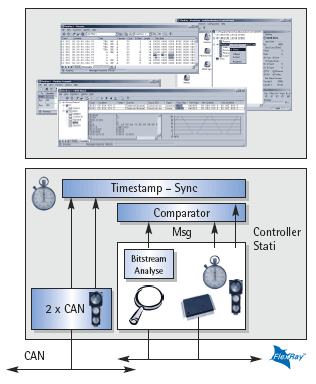With the analysis of FlexRay networks, requirements are made of the measuring hardware that are fundamentally different from the requirements for CAN networks, for example.
Whereas with a CAN analysis system, the use of a communication controller is generally sufficient for bus analysis, in the case of FlexRay additional measures must be taken to be able to analyze start-up processes and errors. A FlexRay communication controller, for example, is not capable of receiving messages during the start-up phase required for establishing the deterministic communication and passing them on to an analysis system. In addition, not all errors relevant for the FlexRay bus analysis can be reported by a FlexRay communication controller.
With its FlexRay/CAN-PC interface "FlexRay CCM" respectively "FRC-EP150", IXXAT pursues the approach of the combined FlexRay analysis consisting of asynchronous bit stream analysis and synchronous analysis with the aid of a FlexRay communication controller. The FlexRay bit stream is thus scanned by an independent system and the FlexRay communication controller is operated at the same time. The results from both sources are compared and results additionally obtained are supplied to the analysis software.

Together with the IXXAT multibusAnalyser, the FlexRay/CAN- PC interface FlexRay CCM / FRC-EP150 therefore provides a powerful analysis environment for the synchronous analysis of FlexRay and CAN networks. The FIBEX import provided by the multibusAnalyser allows an analysis both at message level and at signal level. FlexRay and CAN networks can also be stimulated via transmit functions. The open .net interface enables simple implementation of customized function modules, displays as well as node and rest bus simulations. An additional code generator also enables access to FlexRay and CAN messages via application parameters (signals), which are already generated in the form of .net assemblies (see multibusAnalyser).
Residual Bus Simulation for FlexRay
The residual bus simulation provides a simulation environment for one or more control devices, so that they can be tested independently of other nodes. This includes the generation of message traffic that is necessary for the device to be tested and reaction to messages. In addition, the FlexRay residual bus simulation ensures that at least two FlexRay cold starters are available so that the FlexRay network can be started. With the dual chip extension of the FlexRay CCM / FRC-EP150, one device can represent two cold starters and thus start a network with FlexRay integration nodes only.
Residual Bus Simulation for CAN
In addition to the FlexRay ECUs and Signals, the optional CAN Residual Bus Simulation allows the integration of the CAN ECUs and Signals into the simulation. At this, the Fibex file provides the data for the configuration of the combined simulation range. The CAN Residual Bus Simulation runs in parallel on the FlexRay CCM / FRC-EP150 and supports the simultaneous simulation of FlexRay and CAN signals.
The generation of the FlexRay message traffic for the residual bus simulation is frequently connected with real-time requirements. This means that response data are expected within a specified time, usually within a message cycle, by the control device to be tested and the simulation of the Flexray message traffic must be provided in real time. The IXXAT FlexRay CCM / FRC-EP150 supports real-time residual bus simulation directly on the hardware via a Linux-based embedded programming environment. The code to be processed is dynamically loaded in kernel mode to the FlexRay CCM / FRC-EP150 and processed. FlexRay and CAN messages can be received and pvocessed further and response data can be sent in real time. A framework and C-interfaces are available for this. A GNU compiler with a download tool that runs on Windows translates and loads the program modules to the FlexRay CCM / FRC-EP150, which are stored there on the flash file system. It is also possible to control the embedded residual bus simulation via the PC with data transfer, as is stand-alone operation (i.e. operation of the FlexRay CCMs / FRC-EP150s without a PC). For low real-time requirements i.e. when response times of 10-20 ms are sufficient, the residual bus simulation environment via the .net interface of the multibusAnalyser is available.
Apart from the residual bus simulation, the embedded programming environment of the FlexRay CCMs / FRC-EP150s also offers the possibility to implement gateways, transport protocols or ECU emulations.
The embedded programming package for the FlexRay CCM / FRC-EP150 consists of support of stand-alone operation, embedded frameworks for FlexRay and CAN with the necessary development and download environment.
| 1.02.0243.00000 | FlexRay Residual Bus Simulation |
| 1.02.0243.00002 | FlexRay and CAN Residual Bus Simulation |
| 1.02.0245.00000 | Residual Bus Simulation Runtime Full License for FlexRay CCM and FRC-EP150 |